Once, your mail might have come by trolley or even through a series of tubes

Extended mail trolley in 1900, which carried both mail and riders. From the National Postal Museum.
As the 20th century approached, Boston was choking on its own success - its streets were just too crowded. Today, the Green Line is a reminder of the innovation it took to deal with the problem - the nation's first subway and all, opened in 1897.
But putting trolleys, and eventually longer subway cars, underground wasn't the only way Boston tried to overcome its over-clogged streets. Dedicated mail streetcars and pneumatic tubes also played a key, if ultimately just short-term, role.
By the late 1890s, Boston-area trolley systems, in particular the West End Railroad, which was possibly the largest streetcar system in the US, had largely converted their horse cars to electric-powered vehicles - in fact, they were so successful at moving people that they themselves had become a major part of congestion in downtown Boston, where "cars" from everywhere converged.
The Post Office, headquartered in Post Office Square, though, still relied on horse-drawn wagons to move mail around, as seen in this 1895 photo outside the main post office (from the National Postal Museum):
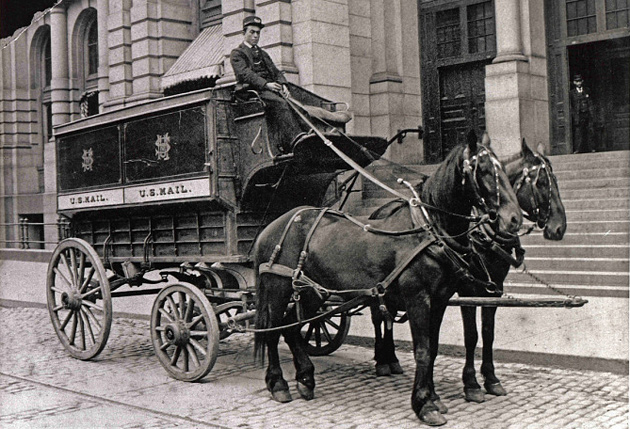
In 1895, though, the Post Office and the West End Railway teamed up: The streetcar company took seven old horse-drawn streetcars from its South Boston line, added electric motors and converted them into mobile mail movers. The Post Office supplied workers - who used cubbies also installed by the streetcar company to sort mail while moving along their routes (from The Electrical Engineer, 1895):
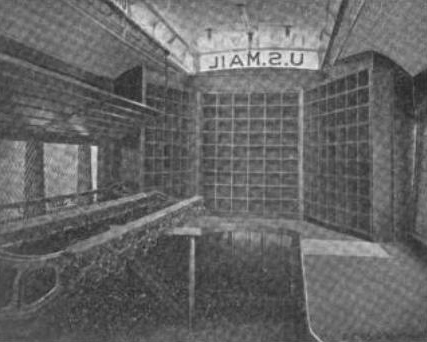
The cars were painted white, in part to help people realize they wouldn't pick up passengers (from the Street Railway Journal, February, 1896):
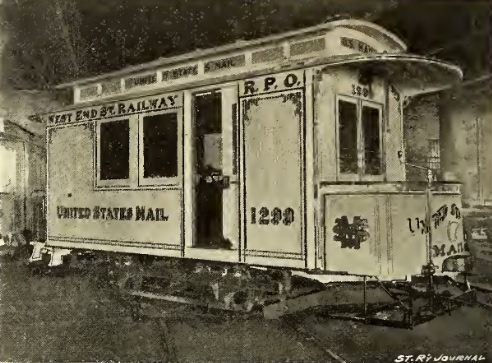
The system started up on May 1, 1895, with five routes, each with six to eight trains in each direction a day between Post Office Square and outlying post offices and major train stations, starting around 5 a.m. One route served Back Bay, Brookline and Brighton; another, the South End and Roxbury, with most cars going up and down Washington Street - with one car a day diverting through Copley Square. A third route had cars going between Post Office Square and Cambridgeport, Central Square and North Cambridge - with one car a day going through Copley Square; while the fourth route clanged its way to East Cambridge and Somerville. Another route served South Boston and Dorchester.
In an article on trolley mail service, the National Postal Museum writes:
One of Boston's busiest trolley cars was even equipped with an electric canceling machine. The clerks were able to cancel 2,000 covers per hour.
Each trolley mail car was typically staffed by two to four mail clerks. They were responsible for taking mail out of the bags loaded on at either a post office or a train station and sorting it along the route, re-packaging it for carriers. The clerks referred to a plan of the city, showing how districts were divided by carriers. Clerks would bundle letters by district for each carrier. Bags containing the letters for carriers who worked out of a substation were taken off the mail cars at the substation. It was then taken by a clerk to its destination. Mail destined for points out of the city was placed in bags which were deposited at the central post office or railway station.
In addition to the mail clerks, two employees of the trolley company were usually assigned to the cars. The company employees were the motorman, who was responsible for running the cars which traveled alone, and a conductor, (who would keep the car on schedule and handle the trolley rope and switching) or a trolley boy (who would be responsible for replacing the pole whenever it jumped a wire).
Ironically, the Post Office rejected a proposal to use an existing tunnel under the main post office for loading and unloading of mail cars; deeming it more important to continue using it for traditional mail wagons. And a Boston Transit Commission plan to build an entirely underground trolley route from Boylston Street to Post Office Square never got beyond excavating a short distance of tunnel just past Boylston station.
The West End Railway quickly added a nighttime route, the Boston Circuit, to collect mail from suburban post offices - and letters handled by it got special postmarks (from the National Postal Museum):
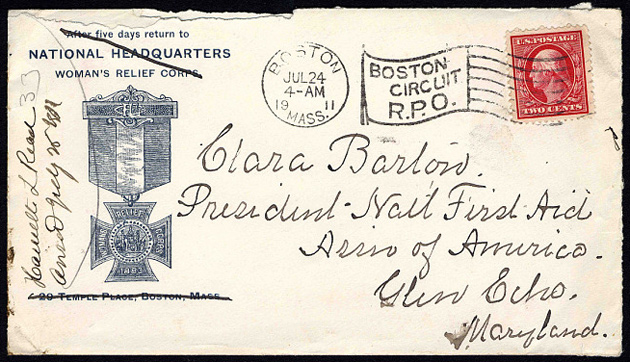
But not long after the turn of the century, trolley mail faded out, as the Post Office switched from horse-drawn wagons to motorized trucks - although in Boston, they lasted at least long enough to have the Boston Elevated Railway, which took over the West End trolley system in 1897, buy new cars for the mail service. And as late as 1909, BERy was reporting $37,977 in annual income from carrying mail (from American Street Railway Investments, 1910).
But only 2 1/2 years after starting in-city mail-rail service, the Post Office began a new service that, as the Globe trumpeted, promised "CANNON BALL SPEED" for letters and packages: A 4,500-foot-long series of tubes between Post Office Square and what was then called North Union Station that could blast mail-carrying brass cylinders at 60 m.p.h. between the two locations.
Using a single 60-hp engine to create a pressure of 6 psi, the system was inaugrated on Friday, Dec. 17, when Gov. Roger Wolcott loaded up the first mail-bearing "cartridge" and released a lever that launched it to North Station.
And there it was unloaded, packed with a bouquet of red and white roses and sent back to the Post Office, where Boston Pneumatic Transit Co. President W.E.L. Dillaway presented the flowers to the governor, to a rousing applause, the Globe reported - adding the entire round trip took 3 minutes and 15 seconds.
Each of the cylinders, 21 inches long and 8 inches wide - four times wider than the cylinders used in older European systems - could carry 600 letters.
Pneumatic-tube sending and receiving apparatus at the main post office (from Transactions of American Society of Mechanical Engineers, 1899:
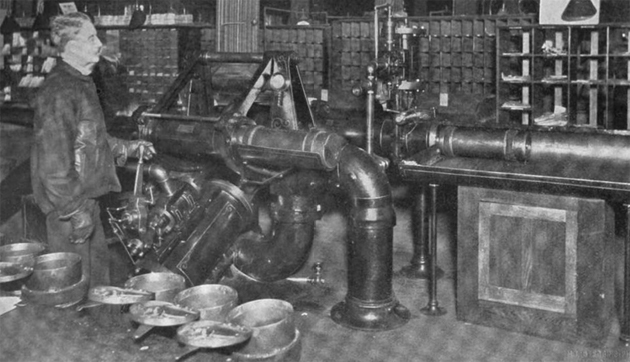
Boston Pneumatic Transit, which made money by charging the Post Office, eventually built nearly 14 miles of tubes under Boston. In 1898, the legislature gave the company permission to build its tubes across Fort Point Channel, alongside what is now the James Kelley Bridge, and to Harvard Square, alongside the Harvard and Warren bridges.
In 1900, the Globe published a look at life in Boston in the year 2000, which included predictions of pneumatic tubes to every home, speeding delivery of the mail - and, of course, the day's issue of the Globe.
But the system only lasted until 1918. Although reliable, it was way more expensive than trucks - and as trucks grew larger, they could carry more mail than even a tube system pumping mail through tubes at 60 m.p.h. In 1918, Congress pulled the plug. In 1926, some entrepreneurs tried starting a new pneumatic-tube system in Boston, but it never went very far.
Post Office Square in 1890 - post office on the left (From the BPL; also see a better view of the building):
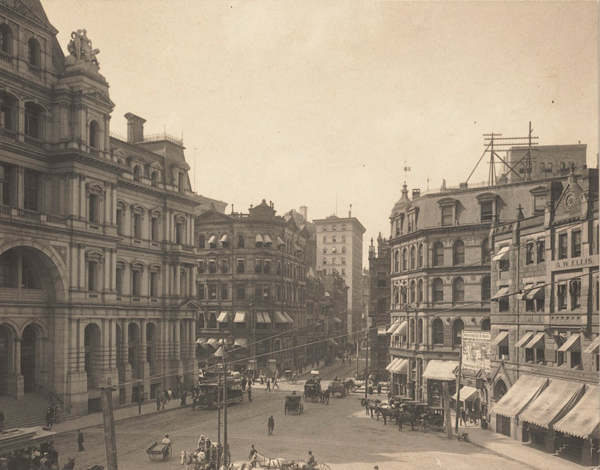
Ad:

Comments
Fascinating!
Great story.
One small typo: the mention of "2018" in the next to last sentence
Thanks, and thanks!
Typo (numbero?) fixed.
I'd guess numero
As in numerographical (as typo is short for typographical).
Thanks Adam,
I needed this right about now.
Fascinating
Thanks!
Eventually though, the series
Eventually though, the series of tubes got their revenge on the big mail trucks that once put them out of business.
Attention mail recipients:
The next batch of bills and junk mail is now approaching...
Railway Post Offices
While this streetcar system may have been short-lived, similar railway cars carried the bulk of intercity mail in the country for nearly a century. The Railway Post Offices—or RPOs—were part of most passenger trains, and mail was collected, sorted and distributed along the route. Mail could be delivered to the train station or the train itself, which generally resulted in faster processing times, often overnight if the destination was along the route of the train.
Probably most impressive is that many deliveries were made "on the fly." Without slowing down, an RPO worker would not only kick a bag of mail out onto a platform at a station, but also use a hook to "catch" a bag suspended waiting for the train. This operation was done at whatever the track speed of the train was, and while the fastest trains of the day didn't generally carry mail cars, it was regularly done at speeds of 70 mph or more.
What happened to that startup
What happened to that startup that ran Internet data cables through the abandoned tubes?
It wasn't that long ago that Amtrak stopped carrying mail.
okay
this is new to me and I like to think of myself is boston tech god
I Know there was some failed ISP(s) in the 90s that tried to run cables thru the city but I assumed it was using shared egress with telcos or something.
Links if you have them!!
I remember
Reading something in South Station saying that there is "Megaband" running under ground there. The only link I can find is an old article that says it was a service offered by RCN.
https://boards.fool.com/rcn-provides-service-to-boston-housing-authority...
Looks like
RCN acquired them at some point..
Their stuff on their website refers to Megaband as their fiber optic internet.
As a part of the Big Dig lots of utilities were upgraded.
I remember reading that lots of communications cables were being replaced with fiber-optics which would run on either side of what is now the Tip O'Neil tunnel. Then again they told us lots of stuff about the Big Dig.
I'm having trouble finding
I'm having trouble finding links. I have a vague memory of an attempt to run data lines through abandoned pneumatic tubes in downtown areas, but I don't think it was in Boston.
http://lapsedhistorian.com/get-blower-londons-forgotten-pneumatic-messag... has a brief mention of such a scheme in London.
Better link, since the
Better link, since the article is now history itself:
https://web.archive.org/web/20180303112743/http://lapsedhistorian.com/ge...
Amtrak stopped carrying mail
because Congress forced them to stop carrying mail.
How interesting!
Adam, thank you as always for highlighting fun Boston facts. Really enjoyed this story.
Beach Pneumatic Tube
One could argue that the Beach Pneumatic Tube in New York was the first subway system in the US.
The Beech Pneumatic Tube
was the first passenger carrying subway in the US. However, I wouldn't describe it as a system.
And, knowing full well he would never get a permit to build a subway from Tammany Hall (Boss Tweed had a lock on all the elevated railway companies and wanted to protect his interests), Beech applied to construct a pneumatic postal tube. He then quietly increased the size of the tube.
While Beech's subway was considered a success, it was a one car novelty that went from its terminal halfway under Broadway, and then back again. The principle could not be effectively applied on a larger scale with multiple stations.
National Postal Museum
Well worth a visit, and only takes an hour or so. Adjacent to Union Station,which is also worth seeing, at the foot of Capitol Hill. Once things return to quasi normal, DC is an amazing place full of incredible free places to visit. (Forget about politics, appreciate the Country and its history and accomplishments.)
https://postalmuseum.si.edu/virtual-tour
I've been to DC several times since the early 1980s
It's one of those places I'll never tire of going to.
Nice
I have noticed an uptick during the pandemic of these longer format "about this boston thing" . Its all good. I mean this is Universal Hub, all things Boston. :-)
But also
As quoted in a story posted on a news site on the internet. ahem.
In tech double entrada slag "how big is your pipe" isn't asking about plumbing, but how big/fast your internet connection is.
Tubes.. pipes.. internet. :-)
Look at it this way.
If the tube system was actually in place today, it probalby would be clogged with all those unwanted deliveries of Globe Direct.
Well, look
It's not a big truck--it's a series of tubes.
Wow!
As a kid I was a subway/trolley buff and have been in all of the abandoned / "secret" tunnels... but never heard about the mail tunnels! Great stuff!
Small pneumatic tube systems were common
In around 1980 I worked in a large Manhattan office building that had a pneumatic tube system. the carriers were maybe 5 inches in diameter by 18 inches long. On the end of the cartridge were a couple of cams you could twist to indicate the desired destination. You'd put the documents or small office supplies into the cartridge, set the cams, open a flap covering the end of a pipe, and let the suction whoosh the cartridge into the innards of the building. When it reached its destination, the cams on the cartridge would engage something in the tube that would cause the cartridge to be diverted from the main pipe into a side pipe, where momentum would carry the cartridge through a trap door that covered the end of the pipe, causing a bell to ring and the cartridge to drop into a basket. They were no longer used much by the time I worked there but the system was in perfect working order and was amusing to play with.
Some stores used to have them, maybe?
I seem to remember seeing people using pneumatic tubes in some downtown department store back in the 80's (1980's, that is.) Maybe Filenes or Lechmere or the Basement?
There are plenty of small
There are plenty of small tube systems today. In stores they bring cash from the vault to the registers. Hospitals use them to move medications and lab samples.
I'm pretty sure Filene's
I'm pretty sure Filene's Basement did. Maybe a Lechmere or two.
I have some vague memories of running into them in some other places in the last 20-25 years... Maybe Spag's? Some other place... slightly old school and slow enough pace inside that they still used them to send from individual service desks to a central cashier or stockroom...
Of course, the tech is mostly seen in bank drive-through lanes these days.
There was never a Lechmere in downtown Boston
Still tubes in use...
There are still pneumatic tubes in use. A couple of years ago, I had a routine blood test at Beth Israel's outpatient center (the Shapiro building) in early evening, shortly before their closing time. The phlebotomist filled a few small plastic vials with my blood, slapped a label on them, and told me I'd get the results the next day.
What actually happened the next day was I got a phone call or email or something, telling me to come back to the center and have blood drawn all over again. It seems they put the blood vials into a canister, which was put into a pneumatic tube system, which was supposed to zip the blood samples to their lab, which is in a different building somewhere on the Beth Israel campus. Something went wrong and the canister got stuck, or anyway was left in the tubes overnight. By the time they retrieved it the samples had "expired."
Annoying, but I went back as requested. This time I discussed the tube system with the phlebotomist, and she showed me the latched, circular door mechanism built into the wall, which I hadn't noticed the previous time. Looked like something you might see in an old WW2 submarine movie.
Modern pneumatic tube systems..
They seem to be pretty practical in large hospital campus settings. Here's a demonstration of how one such system is used in a hospital in Reno.
They really missed the boat
by not decorating the carriers to look like cartoon images of spaceships.
Christian Science Motherchurch complex had (has?) them.
Back in the late 80s, early 90s anyway. All the building were connected to the same large underground structure and people would use the tubes to send messages from one building to another.
Awesome History!
These special cars and services are so rarely talked about in depth. Several small, rural New England trolley systems also used passenger/freight "combines". Just letters? How about fresh milk and produce! The Amherst & Sunderland, Shelburne Falls & Colrain and other western Massachusetts companies ran special trips for the farmers.
Trolley freight was a nice way for the massive Bay State Street Railway {predecessor of the Eastern Mass, whence the modern MBTA bus routes of the North and South Shore are derived} to make money off its more remote lines.
Fun fact: The longest trolley line in New England ran during the teens from Boston to at least Woronoco, MA. The passengers were all fresh fish!
rail mail
Alot of mail was handled and sorted through rail back in the day. Ironically rail carriers are carrying intermodal's of UPS and FedEx still today, but not USPS. I wonder if Biden will make rail a priority.
A different type of tube is
A different type of tube is really common in triple deckers: speaking tubes as front door intercoms. How many people know what those holes above the mailboxes are for and still use them?